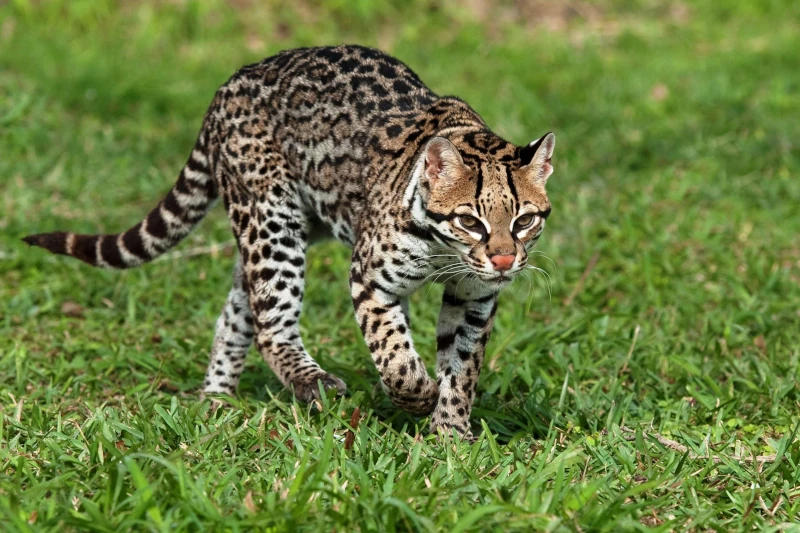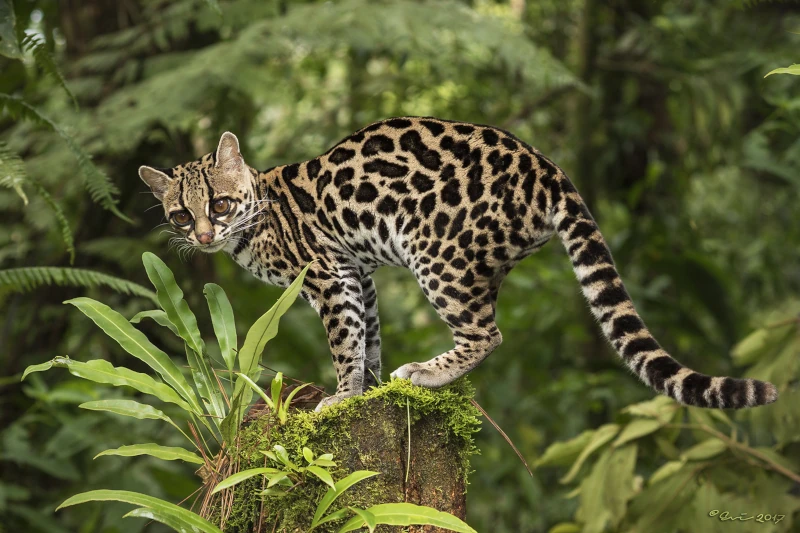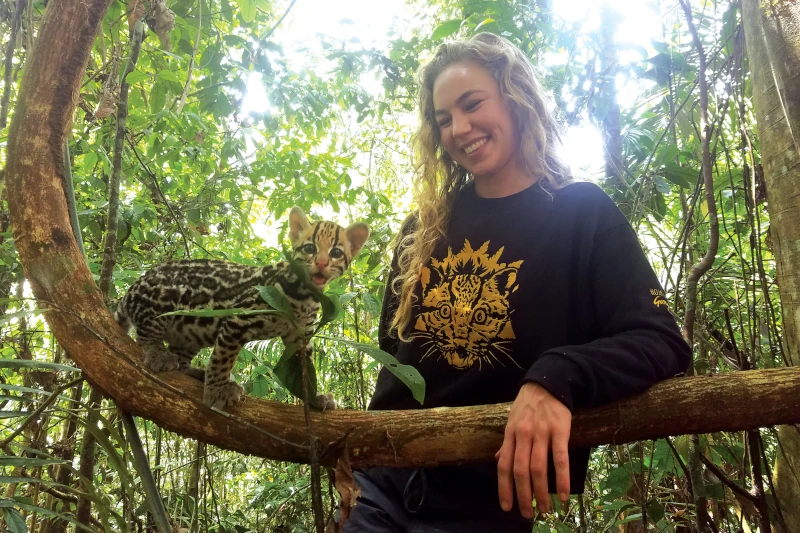Exploring the depths of the rainforest can be an awe-inspiring adventure, especially when you’re on the lookout for the elusive jungle cats. These magnificent creatures have evolved an impressive array of adaptations that allow them to thrive in such a challenging environment. In this article, we delve into the fascinating world of jungle cats, exploring their unique characteristics, habitats, and survival tactics. Whether you’re a corporate executive planning a leisurely escape, a freelance photographer in search of the perfect shot, or an academic researcher gathering cultural insights, understanding these jungle dwellers can add depth to your exploration.
Jungle cats are a diverse group found across various tropical regions, including the lush expanses of the Amazon in Peru and the vibrant forests of Tambopata. The diversity among them is astounding, with each species possessing unique physical traits and behaviors that allow them to thrive in their specific habitats. Some jungle cats, like the ocelot, are known for their striking patterned coats, which provide excellent camouflage in the dappled light of the forest floor. Others, such as the margay, have evolved extraordinary climbing abilities, allowing them to navigate the canopy with ease.
The distribution of these cats is influenced by the availability of prey and habitat conditions. While some species can adapt to various environments, others have very specific habitat requirements. Understanding these differences is crucial for conservation efforts as each species plays a unique role in its ecosystem.

The ocelot, with its beautiful rosette-patterned coat, is one of the most recognized jungle cats. This medium-sized cat is a master of stealth, using its camouflage to blend seamlessly into the underbrush. Ocelots are primarily nocturnal hunters, relying on their acute night vision to stalk prey under the cover of darkness. Their diet is varied, including small mammals, birds, and reptiles, which they capture using their powerful jaws and sharp claws.
Ocelots are territorial animals, often marking their territories with scent markings to ward off intruders. Their social interactions are limited, except during mating season, when they engage in vocalizations to attract mates. Despite their solitary nature, ocelots are an integral part of the rainforest ecosystem, helping to control prey populations and maintain ecological balance.

Known for its incredible agility, the margay is a true acrobat of the jungle. Unlike most cats, margays have flexible ankle joints that allow them to rotate their hind feet, enabling them to climb down trees headfirst. This unique adaptation is crucial for navigating the complex three-dimensional environment of the rainforest canopy, where they spend much of their time hunting and resting.
Margays have large, expressive eyes that enhance their night vision, crucial for their nocturnal lifestyle. Their diet mainly consists of small mammals, birds, and insects, which they hunt with stealth and precision. While margays are solitary creatures, their survival is closely linked to the health of the rainforest, as they rely heavily on the dense forest cover for shelter and hunting grounds.
Conservation efforts for jungle cats are as diverse as the cats themselves, varying significantly based on the specific needs of each species. Protecting their natural habitats is a top priority, as deforestation and habitat fragmentation pose significant threats to their survival. Establishing protected areas and wildlife corridors can help ensure these magnificent creatures have the space they need to roam and hunt.
Additionally, Amazon communities engagement and education are vital components of conservation strategies. By involving local communities in conservation efforts, we can foster a sense of stewardship and encourage sustainable practices that benefit both the people and the wildlife of the rainforest. Public awareness campaigns can also play a crucial role in reducing human-wildlife conflicts and promoting coexistence.
Jungle cats have developed remarkable adaptations to survive in their habitats. Their keen senses, camouflaged coats, and agile bodies enable them to navigate the dense foliage and hunt with precision. These adaptations not only ensure their survival but also highlight the incredible diversity of life in the rainforest.

The sensory adaptations of jungle cats are nothing short of extraordinary. Their keen sense of smell allows them to detect prey and potential threats from a distance, while their acute hearing helps them pinpoint the slightest rustle of leaves or the faintest call of a bird. These heightened senses are essential for survival in the dense and often noisy environment of the rainforest.
In addition to their auditory and olfactory prowess, jungle cats possess remarkable vision adapted for low-light conditions. Their eyes have a high concentration of rod cells, which enhance their ability to see in the dark, making them effective nocturnal hunters. This combination of senses gives them a significant advantage in locating and capturing prey.
The diverse and intricate patterns on the coats of jungle cats serve as a critical adaptation for survival. These patterns provide excellent camouflage, allowing the cats to blend seamlessly into their surroundings. For instance, the spotted coat of the ocelot mimics the dappled sunlight filtering through the canopy, effectively concealing it from both prey and predators.
Camouflage is not only crucial for hunting but also for avoiding detection by larger predators. By remaining hidden, jungle cats can stalk their prey more effectively and reduce the risk of confrontation with other carnivores that share their habitat. This adaptation is a testament to the evolutionary pressures that have shaped these remarkable creatures.
The physical agility of jungle cats is a marvel of natural engineering. Their lean, long legs, muscular bodies are designed for speed and stealth, enabling them to move silently through the underbrush and launch swift, decisive attacks on unsuspecting prey. Their retractable claws and padded paws allow them to climb trees with ease, providing access to both arboreal prey and refuge from ground-based threats.
Agility is not just about speed; it’s also about precision. Jungle cats are capable of making split-second adjustments to their movements, a skill that is particularly important when hunting in the cluttered environment of the rainforest. This ability to navigate complex terrain with grace and efficiency is a key factor in their success as predators.

The rainforest is an intricate eco system, life filled and full of action. To jungle cats, the environment comes with opportunities and challenges too. They are good candidates in hunting and avoiding predators because of their famed agility in the undergrowth and ability to climb trees. The thick cover gives them much cover, and they can stalk easily without detection or quickly escape when such a time arises.
Jungle cats have the skills of maneuvering through the maze of the rainforest; their sharp senses and knowledge of their domain enable them to find meals and escape the enemies. They have a tendency to have defined routes in their boundaries, which they revisit to identify boundaries and alterations on availability of prey. It demonstrates their resourcefulness and adaptability, the strategic use of their environment.
Trees play a crucial role in the lives of jungle cats. They provide shelter, hunting grounds, and escape routes from potential threats. The concept of a “cat tree jungle” is not just a playful metaphor but a real aspect of their survival, as these cats often rest and hunt from tree branches. Trees offer a vantage point from which they can survey their surroundings and detect approaching danger.
The vertical dimension of the rainforest is particularly important for species like the margay, which spend much of their time in the canopy. Trees offer a rich array of prey opportunities and are a vital component of the margay’s hunting strategy. The ability to move effortlessly between the ground and the treetops is a distinctive feature of many jungle cats felis chaus, highlighting the importance of preserving forested habitats.
Habitat loss is one of the most significant threats facing jungle wild cats today. Deforestation, driven by agriculture, logging, and urban expansion, has led to the fragmentation of many rainforest ecosystems, isolating populations and limiting their access to essential resources. This loss of habitat not only reduces the available space for jungle cats to roam and hunt but also disrupts the complex ecological interactions that sustain them.
Conservation efforts must preserve the Amazon, contiguous tracts of forest to ensure the survival of these elusive felines. Establishing protected areas and wildlife corridors can help mitigate the effects of habitat fragmentation, allowing jungle cats to maintain healthy populations and genetic diversity. Public awareness and sustainable land-use practices are also crucial in addressing the challenges of habitat loss.

Jungle cats are opportunistic hunters with a diverse diet. They prey on small mammals like tapirs, birds for example, hoatzins, reptiles, and even insects. This varied diet is essential for their survival, especially in areas where food sources may fluctuate. Understanding their dietary habits can provide insight into the delicate balance of the rainforest ecosystem.
These cats are equipped with sharp claws and teeth, excellent night vision, and acute hearing, making them formidable nocturnal animals. Their stealth and patience are key to their hunting success, allowing them to ambush prey with precision. Many jungle cats employ a “sit-and-wait” strategy, positioning themselves near game trails or water sources to maximize their chances of encountering prey.
In addition to ambush tactics, some species, like the Amazon Rainforest jaguar, are known for their powerful bite, capable of piercing the skulls of their prey. This strength allows them to tackle larger animals, such as capybaras and peccaries, expanding their dietary options. Each species has developed hunting techniques tailored to its unique environment and prey preferences.
Human activities, such as hunting and habitat destruction, have a significant impact on the availability of prey for jungle cats. As their natural food sources decline, some cats may be forced to venture closer to human settlements in search of food, leading to increased conflicts and a higher risk of being killed by humans. This situation underscores the importance of preserving natural habitats and implementing measures to minimize human-wildlife conflicts.
Conservation efforts should focus on protecting prey species and restoring degraded habitats to ensure jungle cats have access to sufficient food resources. By maintaining the integrity of the rainforest ecosystem, we can help safeguard the future of these remarkable predators and the biodiversity they support.
Jungle cats communicate using a variety of sounds, from growls and hisses to meows and purrs. These vocalizations play a crucial role in their social interactions, whether it’s establishing territory, attracting a mate, or warding off intruders. Recognizing these sounds can enhance your experience when observing these creatures in their natural habitat.
The vocal repertoire of jungle cats is as diverse as the cats themselves, with each species having its unique set of calls and sounds. These vocalizations serve multiple purposes, from signaling distress to conveying aggression or submission. For example, the low-frequency growls and roars of larger cats, like jaguars, can travel long distances, making them effective for territory marking and communication between individuals in dense forests.
Small cats, like the margay and ocelot, often rely on higher-pitched calls, such as chirps and meows, to communicate with their young or signal their presence to potential mates. The complexity of these vocalizations reflects the intricate social dynamics of jungle cats and their need to navigate the challenging environment of the rainforest.
Despite their solitary nature, jungle cats engage in various social interactions that are vital for their survival and reproduction. Vocalizations play a key role in these interactions, allowing cats to establish and maintain territories, attract mates, and communicate with their offspring. During the mating season, males and females use specific calls to locate each other and coordinate breeding activities.
Territorial disputes are often resolved through vocal displays, with cats using growls, hisses, and other sounds to assert dominance and deter rivals. This vocal communication helps minimize physical confrontations, reducing the risk of injury and conserving energy for hunting and other essential activities.
Whether you’re heading to the Amazon in Peru or the rich forests of the National reserve of Tambopata, understanding the behavior and habitat of jungle cats can enrich your travel experience. Here are some tips for planning your journey into the Manu National Park:
Jungle cats are a testament to the adaptability and resilience of the unique wildlife in the rainforest. By understanding their adaptations and behaviors, you can gain a deeper appreciation for these remarkable creatures and the ecosystems they inhabit. Whether you’re exploring the Amazon or another jungle paradise, let the jungle cats be your guide to the wonders of the wild.
The intricate beauty of the rainforest and its inhabitants offers endless opportunities for discovery and inspiration. By immersing yourself in this vibrant world, you can connect with nature wildlife on a profound level and gain a greater appreciation for the delicate balance that sustains life in the jungle. Embrace the adventure, respect the environment, and let the jungle cats lead you on a journey of exploration and wonder.